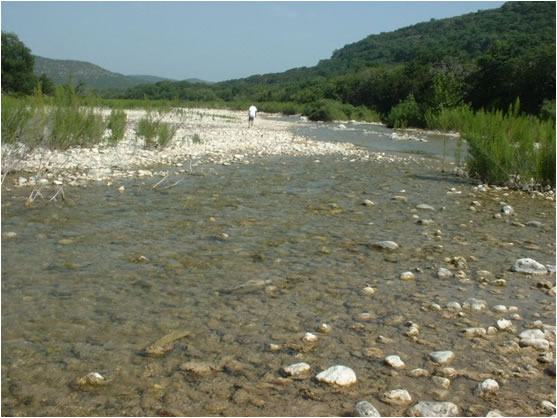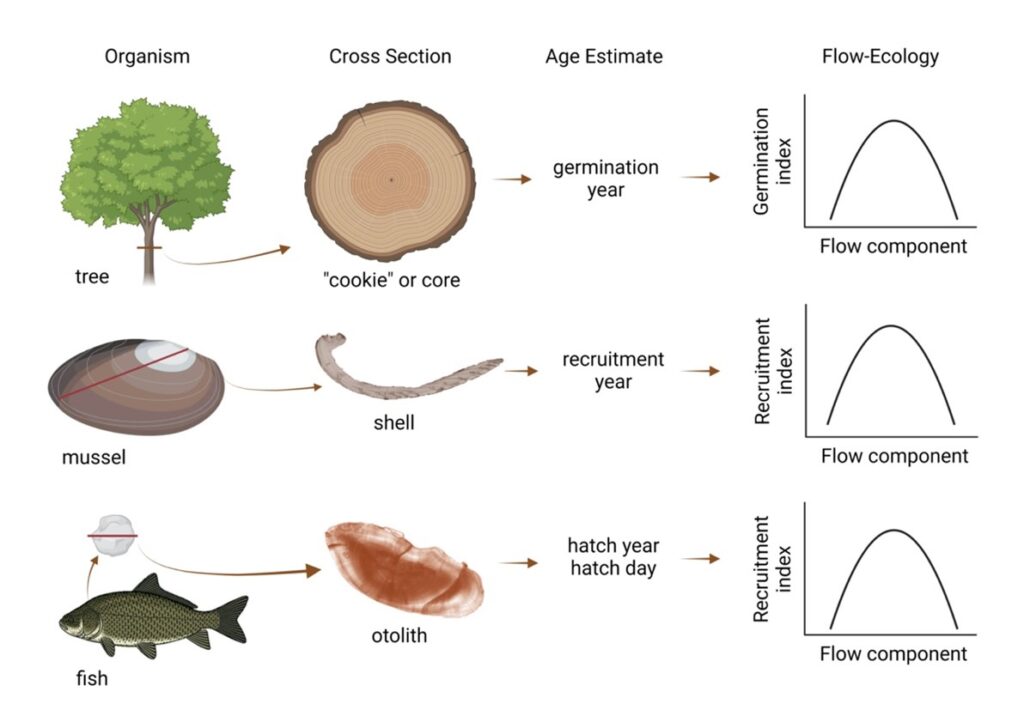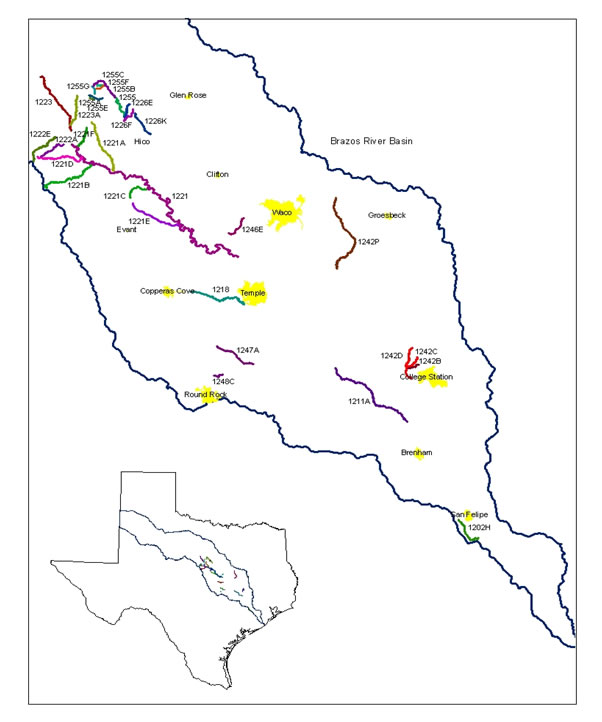Texas Surface Water and Environmental Flows
Environmental Flows
As in most regions of the world, Texas is confronted with serious issues related to water supplies in support of economic life, human health and welfare, and environmental health. Aquatic Ecology Lab conducted studies to contribute to the challenge of estimating environmental flow needs for the state’s streams, rivers and estuaries. Dr. Winemiller has assisted the state with recent programs to evaluate technical approaches and to assess environmental flows. Links to related websites and documents appear below.

Advancing Environmental Flows Science: Hindcasting and Forecasting Flow-Ecology Relationships
Kirk Winemiller, Joshuah Perkin & Aaron Trimble, Texas A&M University; Joseph Trungale, The Nature Conservancy; David Hoeinghaus & Cole Reeves, University of North Texas, Denton, TX; Georgianne Moore, Georgia Southern University; Astrid Schwalb, Thomas Hardy & Zachary Mitchell, Texas State University; Thomas B. Hardy, Department of Biology, Texas State University, San Marcos, TX; David Buzan, Freese & Nichols
To advance current environmental flow standards in Texas, we developed field, laboratory, and analytical methods to model recruitment dynamics of indicator species selected to cover a range of population responses to flow variation. Preliminary investigations were conducted in three central Texas river basins to evaluate the feasibility of these methods for formulating and evaluating the state’s environmental flow standards. Age analysis allowed back-calculation of dates of fish hatching, mussel recruitment, and tree germination for estimation of temporal variation in recruitment. Recruitment data were then analyzed in relation to flow regime components. Statistical models were derived for flow-recruitment relationships of Shoal Chub (Macrhybopsis hyostoma), Smallmouth Buffalo (Ictiobus bubalus), Threeridge Mussel (Amblema plicata), and Boxelder (Acer negundo). The Shoal Chub model was used to hindcast recruitment dynamics in the Brazos River, revealing a decline in recruitment after dam construction. The Smallmouth Buffalo model revealed that strong year classes were positively associated with springtime pulses of long duration but negatively associated with frequent short-duration pulses. Results for the Threeridge Mussel were not as easily interpreted, but for all three river basins generally showed weaker recruitment during periods with extreme low and high flows. The Boxelder model revealed positive associations between recruitment and high flow components and was used to forecast the probability of germination under five simulated flow regime scenarios, thereby providing an additional means for evaluating the suitability of environmental flow standards. Assessment of how hydrology influences recruitment provides an evidence-based method to hindcast responses to past flow regimes and forecast responses to future flow scenarios, thereby providing a basis for evaluating environmental flow standards and water management options.
This effort was funded by a contract with the Texas Water Development Board.

Winemiller, K.O., J.S. Perkin, J.F. Trungale, D.J. Hoeinghaus, G.W. Moore, A.N. Schwalb, Z.A. Mitchell, A. Trimble, C. Reeves, M.R. Acre, K. Wheeler, T.B. Hardy, and D. Buzan. 2024. Advancing the state of environmental flows science: monitoring, hindcasting and forecasting flow-ecology relationships. Fisheries, In press.
Estimating indicator species recruitment to evaluate environmental flow components
A set of environmental flow indicators should include species that are highly responsive to flow variation, with a particular focus on requirements for reproduction and recruitment that sustain populations. The set should cover a range of flow tiers, from base flows to flow pulses of various magnitudes, frequencies, and durations at critical times of the year. For example, most sunfishes (Centrarchidae) have greatest reproductive success when flows are relatively low and stable during the period of reproduction and feeding/growth of early life stages. Similarly, unionid mussels are adversely affected by extreme low flow and high flows, although some species may do well in flow refuges during high flows and may benefit in the long term from substrate scouring that reduces siltation. Certain minnows, such as broadcast spawning chubs (Macrhybopsis, Leuciscidae) with drifting eggs and larvae, generally spawn during small flow pulses that may occur frequently during an extended spring-summer reproductive period. Flow pulses of greater magnitude but lower frequency trigger spawning by many large, long-lived fishes, such as suckers (Catostomidae) and gars (Lepisosteidae). Floods of long duration often enhance juvenile survival and recruitment to the subadult stage with potential for establishment of strong annual cohorts that sustain populations. Similarly, riparian trees, such as Boxelder (Acer negundo), have enhanced germination rates and greater seedling survival and growth when high flow pulses provide sufficient moisture during appropriate times of the year. Unlike short-lived species that must have some degree of reproductive success each year, long-lived species may only need suitable flow pulses to occur every several years for recruitment of dominant cohorts that sustain their populations.

Recruitment in relation to flow variation can be estimated by sampling populations over appropriate time intervals and locations, determining specimen ages, estimating hatching or germination dates based on ages, and performing statistical analyses to derive models predicting recruitment as a function of relevant flow regime variables from the antecedent flow record for the location. This rates-based approach requires reliable methods for age determination, and therefore some flow-sensitive organisms may be unsuitable as indicators. Because sufficient samples are needed for estimation of recruitment strength, some flow-sensitive species may be too rare to be suitable indicators. Other species may be abundant but having population dynamics that are fairly insensitive to flow variation (e.g., Mosquitofish, Gambusia affinis, a small livebearing fish with high population resilience, environmental tolerance, and ability to rapidly colonize shallow, frequently disturbed habitats).

RUAA Studies in Texas River Basins
Over the past several years, the Aquatic Ecology Lab has assisted the Texas Commission on Environmental Quality (TCEQ) by conducting RUAAs for river and stream segments throughout the state. Following TCEQ’s 2009 Recreational Use Attainability Analysis Procedures, team members consult landowners, interview recreational users, and collect environmental data. This information is used by the Water Quality Standards Team within the TCEQ to potentially classify or reclassify streams in the categories of Primary Contact Recreation, Secondary Contact Recreation 1, Secondary Contact Recreation 2, and Noncontact Recreation. Field surveys and data collection for the RUAA projects are managed by Dr. John Baker, Research Associate in the Aquatic Ecology lab.

Helpful Websites with Information about Texas Environmental Flows Programs
Instream Flows in Texas, Texas Parks and Wildlife
Fact sheet to provide a succinct and general overview of the main issues and state‐of‐the‐art approaches involved in establishing environmental flow regimes. The emphasis of this fact sheet is on fishes, but it must be recognized that environmental flows support other biological components of river ecosystems, including riparian forests.
Environmental Flows, Texas Water Development Board
The flow of water (both quantity and timing of flow) needed to maintain ecologically healthy streams and rivers, as well as the bays and estuaries that they feed.
Environmental Flows, Texas Commission on Environmental Quality
Recommendations regarding methodologies for establishing appropriate environmental flow requirements for Texas water bodies, specifically improving what is referred to as “desk-top” methodology for estimating the flow requirements in rivers and streams necessary for conserving instream uses and the aquatic environment.
River Science Fact Sheet
Dr. Kirk Winemiller prepared this fact sheet to provide a succinct and general overview of the main issues and state‐of‐the‐art approaches involved in establishing environmental flow regimes. The emphasis of this fact sheet is on fishes, but it must be recognized that environmental flows support other biological components of river ecosystems, including riparian forests.
Information on Environmental Risk Management
Risk management is the process of setting rules or operating procedures for minimizing damage when there is uncertainty about relationships and outcomes.
Review of Desk-top Methods for Establishing Environmental Flows in Texas Rivers and Streams
Recommendations regarding methodologies for establishing appropriate environmental flow requirements for Texas water bodies, specifically improving what is referred to as “desk-top” methodology for estimating the flow requirements in rivers and streams necessary for conserving instream uses and the aquatic environment.
Biological Overlay (Environmental Flow Analysis) for the Sabine & Neches River Basins and Sabine Lake Estuary
Determining environmental flow recommendations for the fluvial realm of the Sabine and Neches river basins (tributary streams and mainstem rivers), out BBEST’s biological overlays subcommittee adopted the basic approach recommended by the state’s Environmental Flows Science Advisory Committee.
Nutrients and Biological Responses
Surveying Recreational Uses in Texas,
Texas Commission on Environmental Air Quality
Texas protects the quality of the state’s surface waters to make them safe for recreational uses. Pastimes like swimming, wading, or other activities during which a person might ingest natural waters are referred to as the “contact recreation use” in the state’s Standards for water quality.